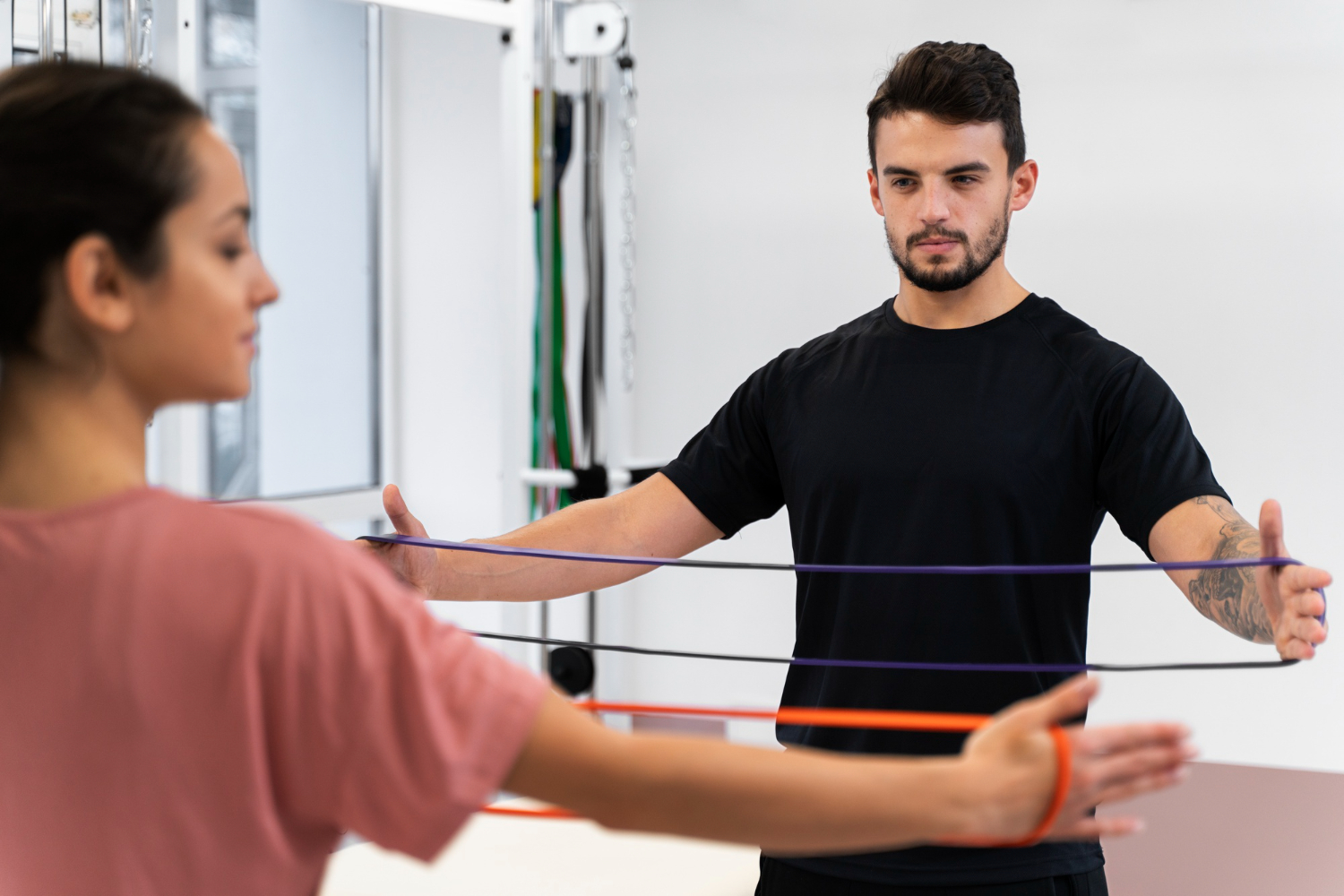Synopsis
Shoulder pain can drastically hinder everyday tasks, affecting your comfort, posture, and quality of life. From stiff necks to immobile shoulders, physiotherapy plays a vital role in resolving these concerns without surgical interventions. This blog explores how physiotherapy for shoulder pain and frozen shoulder physiotherapy offer effective, science-backed pathways to healing. We unpack the stages of recovery, pain alleviation methods, and the structured approaches in physio for frozen shoulder and shoulder physio. The article also dives deep into specific treatments like physiotherapy for rotator cuff injury and frozen shoulder physical therapy treatment, helping readers understand when and how to seek intervention. By demystifying pain patterns and discussing how frozen shoulder physio treatment can accelerate mobility restoration, this blog becomes a comprehensive guide to understanding shoulder rehabilitation. Whether it’s post-injury stiffness or an age-related condition, the power of physiotherapy lies in its precision, safety, and non-invasiveness. Read on to explore the journey of recovering mobility through professional physiotherapy care.`
Table of Contents
- Understanding Shoulder Pain and Its Impact
- What is Frozen Shoulder and How Does It Develop?
- How Physiotherapy Helps Shoulder Pain
- Approaches to Frozen Shoulder Physiotherapy
- Rotator Cuff Injuries and Physiotherapy
- Realistic Timelines for Recovery
- Benefits of Medical Supervision in Shoulder Physio
- Orthocure’s Approach to Shoulder Rehabilitation
- Why Choose Orthocure Clinics and Gyms for Shoulder Physio?
Understanding Shoulder Pain and Its Impact
Shoulder pain can stem from a variety of sources including inflammation, injury, poor posture, or degenerative diseases. Everyday movements such as reaching, lifting, or even turning in bed become difficult. Physiotherapy for shoulder pain provides a holistic approach that doesn’t just relieve pain but also focuses on root-cause treatment and long-term prevention. Ignoring early signs can escalate into chronic stiffness, particularly in individuals above 40.
What is Frozen Shoulder and How Does It Develop?
Frozen shoulder, also known as adhesive capsulitis, is characterised by stiffness, pain, and reduced mobility in the shoulder joint. It often develops gradually and worsens over time, typically passing through three phases—freezing, frozen, and thawing. During these stages, frozen shoulder physiotherapy proves crucial in preventing further deterioration and speeding up recovery. The earlier the intervention, the better the outcome.
How Physiotherapy Helps Shoulder Pain
Physiotherapy for shoulder pain uses manual therapy, mobilisation techniques, and progressive exercises to reduce inflammation and increase joint mobility. The therapy often includes posture correction, targeted stretching, and strengthening routines. By focusing on regaining range of motion and addressing compensatory patterns, shoulder physio empowers individuals to regain control over their movements safely and effectively.
Approaches to Frozen Shoulder Physiotherapy
One of the most effective treatments for adhesive capsulitis is frozen shoulder physio treatment. It typically includes joint mobilisation, electrotherapy, dry needling, and range of motion exercises. These interventions, when executed by trained professionals, help reduce capsular tightness and improve mobility without causing pain. Frozen shoulder physical therapy treatment is tailored to each phase of the condition, ensuring progressive improvement.
Rotator Cuff Injuries and Physiotherapy
Another major source of shoulder pain is rotator cuff injuries. Physiotherapy for rotator cuff injury includes isolated muscle strengthening, scapular stabilisation exercises, and resistance band workouts. When left untreated, these injuries can lead to chronic pain and surgical intervention. However, a tailored physio for frozen shoulder routine can prevent complications and promote natural recovery.
Realistic Timelines for Recovery
Recovery from shoulder issues varies based on the condition and patient compliance. While some individuals start noticing improvements in 4–6 weeks, others may take 3–6 months. Frozen shoulder physiotherapy follows a structured programme that ensures consistent improvement. Regular assessment, progress tracking, and personalisation of therapy sessions contribute significantly to timely recovery.
Benefits of Medical Supervision in Shoulder Physio
Receiving physiotherapy for shoulder pain under the guidance of certified professionals ensures safety and effectiveness. Misaligned techniques or overexertion can worsen the issue. Clinics like Orthocure provide frozen shoulder physical therapy treatment with real-time supervision, MedX machines for back and shoulder strengthening, and a pain-free approach to rehabilitation.
Orthocure’s Approach to Shoulder Rehabilitation
At Orthocure Clinics and Gyms, our treatment begins with a scientific diagnosis, followed by frozen shoulder physio treatment tailored to each patient’s needs. We use global best practices and equipment such as MedX shoulder machines to deliver accurate, impactful results. The therapy plan is regularly modified based on patient feedback and strength evaluation, ensuring sustained improvement and prevention of recurrence.
Why Choose Orthocure Clinics and Gyms for Shoulder Physio?
Orthocure stands out with its integrative care model combining advanced diagnostics, physiotherapy, and post-recovery strength training—all under one roof. Our team includes senior physiotherapists trained in frozen shoulder physiotherapy and physiotherapy for rotator cuff injury. The use of safe, medically approved technologies ensures precise results. We prioritise long-term mobility and preventive care for individuals above 30 and seniors alike. Whether you’re dealing with early stiffness or long-standing shoulder issues, Orthocure delivers unmatched care that is safe, supportive, and results-driven.
FAQs
What are the early symptoms of frozen shoulder?
Frozen shoulder typically begins with dull or aching pain in the outer shoulder or upper arm, followed by increasing stiffness and reduced range of motion. These symptoms develop slowly and worsen over time if left untreated. Physiotherapy interventions, such as joint mobilisation and targeted exercises, help manage the condition in its early phases. Recognising these signs early is key to avoiding prolonged immobility and discomfort.
How does physiotherapy treat shoulder bursitis or rotator cuff injuries?
Physiotherapy for rotator cuff injury or bursitis focuses on relieving pain, reducing inflammation, and restoring mobility. Techniques may include ultrasound therapy, manual manipulation, and progressive muscle strengthening exercises. A structured therapy plan ensures that the injury heals properly without the need for surgery. Early intervention often leads to complete recovery.
How long does it take to see results from frozen shoulder physio treatment?
Results can vary based on the stage of the frozen shoulder and patient consistency. Initial improvements may appear within 2–4 weeks, but full recovery often takes 3–6 months. Physiotherapists monitor progress and adjust treatments accordingly. Timely sessions and adherence to prescribed exercises accelerate healing.
Is physiotherapy for shoulder pain safe for seniors?
Yes, physiotherapy for shoulder pain is highly safe for seniors, especially when supervised by certified therapists. Clinics like Orthocure ensure treatments are customised to suit age-related limitations and overall health. Gentle stretching, low-impact strengthening, and guided mobility drills help restore function without strain.
What should I expect during frozen shoulder physical therapy treatment?
During treatment, you’ll undergo assessments to determine stiffness levels, followed by pain management techniques and mobility training. Sessions are progressive, moving from reducing inflammation to regaining strength and flexibility. The physiotherapist may also offer lifestyle advice to prevent recurrence. Every treatment is adapted to your comfort and recovery pace.





